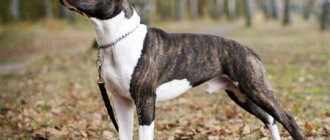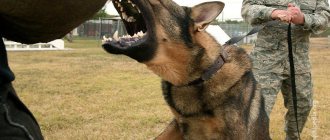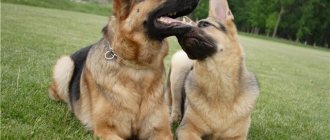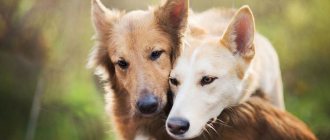Our pets, like their owners, communicate with their own kind. This happens in the yard, on the walking area, and also at home if we get a second pet. And in each of these cases, the question arises of how to introduce a dog to a dog so that no conflict arises. To do this, you need to approach the issue with all responsibility.
Taking care of your pets
As a rule, the issue of purchasing a new animal is decided by the owners. In this case, the pet is simply presented with a fait accompli, without thinking that he needs to be taken into account. Even before introducing dogs to each other, you need to carefully weigh the pros and cons. Having a second pet is always stressful for your pet. It's quite difficult to predict his reaction. Someone may become depressed, another will start urinating in the room, which did not happen before. Therefore, as a last resort, you need to agree with the previous owner about the possibility of return. But it's better to let your dog make a choice with you.
Children
Don’t forget that once a puppy appears in the family, you will have to carefully monitor the children’s behavior. First of all, explain to your child that a living fluffy ball is not a toy and it can also be painful and scary. Show him how to pet the puppy, pick him up and hold him, tell him how not to treat him. Be sure to explain that sooner or later the puppy will get tired of playing and you should not force him to do anything.
Read our next article on how to choose the right food for your puppy.
We observe and remember
Before making a decision, you should pay attention to your pet’s behavior on the playground. Which dogs does he always happily run towards, which ones does he avoid, and which ones does he bark at the sight of? What is their size, breed, gender, age? Some people love to play with puppies, while others, on the contrary, consider it beneath their dignity. Having made certain conclusions, you can find your pet’s best friend and avoid a whole series of troubles.
There is no need to dwell on this. Because some animals will play nicely with other animals on the street, but will not let them into their home. Others will let you in, but will begin to harass you as soon as they realize that the guest is staying forever. Therefore, invite someone from the site to your place and continue observing. This is invaluable information that will greatly help you in the future.
Why introduce pets
If you simply bring in a new dog and leave him with an animal that feels like the boss of the house, it will be stressful for both of them. As you know, stress can provoke the development of many diseases, including baldness or urinary incontinence. We wrote more about stress in cats and dogs in this article.
In addition, the dog can bite the cat. And often the opposite happens, when a cat, in defense, rushes at the dog. This can result in claw cuts to the eyes and other injuries.
Therefore, proper introduction of pets is, first of all, a matter of health and safety.
Meeting on site
Puppies are usually determined to play with anyone. Therefore, when they meet on the street, they greet each other joyfully and start a fuss. In this case, you don’t even have to think about how to introduce the dog to the dog. Everything is like people. Children also make friends much easier than adults.
If you have an adult dog, then it makes sense to be more careful with acquaintances. Alternatively, you can walk at your own time, when the site is unloaded. Or cooperate in groups. This will make it easier to introduce the pets so that they calmly perceive each other. The recommendations here will be standard:
- On the first day, lead the dogs so that they have time to see and smell each other. At the same time, keep them on leashes and muzzles. It is better to spend the rest of the walk separately.
- On the second day, you can walk together throughout the entire time, but do not let the dogs off their leashes.
- If the reaction is adequate and friendly, then from the third day you can safely let them out together on the walking area.
Another thing is how to introduce a dog to a dog if they are clearly hostile to each other. You can’t do this without the help of a professional. But if it’s just a matter of a common walking area, then it’s easier to agree that you will come at different times. This way you will get by with small sacrifices.
Dogs
When you decide that the animals are comfortable enough, introduce them. If you are concerned about the safety of one of your pets, you can begin introductions through the closed door of the carrier. If you are sure that no one will get hurt, carefully bring the puppy to the adult animal’s face; under no circumstances should you hit or scold the pet if they bark or growl at the newcomer. After the introductory sniffing, place the puppy on the floor in front of the old-timer and carefully monitor the reaction of both: if dissatisfaction appears, postpone the introduction to a more favorable time.
If you have adopted a puppy
In this case, close contact between pets cannot be avoided. This means that it is necessary to ensure that good relations are established between them. To do this, you need to know how to introduce a dog to a dog. It is quite possible that your pet is already accustomed to the fact that he is the one and only. Therefore, the appearance of an opponent can be a real shock. To reduce the emotional burden of the first meeting, follow these recommendations:
- Before you bring your puppy home, make sure your adult dog has all its vaccinations. This will ensure that both pets live happily ever after.
- To get acquainted, choose a neutral place that the adult pet will not consider his own. But if the puppy has not yet received all its vaccinations, you should not go far from home with it. In this case, arrange a meeting in the garden.
- The first step is to put a leash on the puppy, then release the adult dog. For the first meeting, you can put a muzzle on her.
- Let them sniff each other while petting and praising both.
Believe me, how the meeting will go will depend on your condition. Therefore, if you are very worried and worried about how to introduce an adult dog to a puppy, then you should not be surprised that the meeting may end worse than it could. And if the owner is calm, then the pets will quickly calm down. They may be excited or nervous about the meeting, this is normal, they will calm down soon.
In a new house
When you bring your puppy home, first leave him in a separate locked room (providing everything he needs in advance). If the pet has been traveling in a carrier and does not want to get out, then leave it open and give the puppy the opportunity to get out on his own.
At this time, your other pets may want to sniff the door of the room - do not forbid them to do this, but rather provide the bedding on which the newcomer was brought. Animals form an impression of the world around them primarily by smell, and this way they can prepare in advance for a “personal acquaintance” with the puppy. When adult pets get used to the new smell, remove the new one from this room and let others in - they will explore the room and get used to the new smell.
Meeting adult animals
If you decide to adopt an adult dog, then you need to be prepared for the fact that your pets will not become friends right away. The process will be easier if there are two females, or a female and a male. The most difficult thing is if you have to work with two male dogs. In this case, you not only need to know how to introduce adult dogs, but also have strong leadership qualities. If you are the leader in the family, then the pet will accept your decision to get yourself another pet. Otherwise, it all depends on how much he “likes” it. Yes, dogs also have their own preferences, which are sometimes difficult for us to understand.
Why cats and dogs are aggressive towards each other
Oddly enough, most often the reason is fear. Moreover, dogs are no less afraid. A pet of a different species is something new and incomprehensible. And scary and interesting at the same time. When a dog reaches out to sniff a cat, the cat instinctively either runs away or defends itself. Seeing such a reaction, the dog gets upset, that is, a negative response occurs. In the future, at the level of reflexes, the dog, trying to protect itself from negative experiences, will bark at the cat. Of course, at this stage, hunting instincts also come into play: when potential “prey” runs away or hides in a corner, the dog becomes interested in catching it.
Our task as owners is to prevent the dog’s hunting instinct from turning on in relation to the cat. If pets do not see each other as a threat, they will be able to coexist peacefully.
See a professional for help
Don't forget that all animals are different. Some are calmer and friendlier, while others, on the contrary, cannot stand being next to each other. How to introduce two dogs if you know for sure that one of them is not friendly, timid or aggressive? In this case, you need to act very gently. For the first time, just show the animals to each other. The second time you will spend next to each other. Repeat this procedure for 5-7 days. If aggressive attacks or panic continue, there is no need to aggravate the situation and push them closer. Contact a canine organization where a specialist will help build a relationship between these two animals.
On a walk. Meeting dogs, greeting ritual
A dog on a walk: why is the ritual of greeting relatives so important, how does it happen, what influences it and how to avoid aggression when meeting dogs?
The greeting is a real dialogue. Having seen each other already at a great distance, the dogs begin to reach out to each other, exchanging signals of reconciliation.
According to studies, dogs show a variety of reconciliation signals when preparing for a meeting. Most often this is licking, yawning and turning away the head. The gaze is directed to the side. Some dogs slow down or begin to sniff the ground, changing their trajectory to approach in an arc. The set of signals is individual in each specific situation. So, for example, if it is not possible to slow down the pace, dogs try to change the trajectory of movement or begin to lick themselves. In the dark, dogs use more visible signals, such as sitting or lying down. Puppies do the same thing when preparing to meet an older dog [1, 2].
The influence of the situation on the course of the dog meeting
Meetings of freely walking dogs most often proceed peacefully, since in this case the animals behave naturally, consistently performing the entire chain of polite movements. At the same time, friendly dogs remain together, and those who are unpleasant to each other disperse at a sufficiently large distance so as not to create conflicts. You can observe such dog communities even within the city, somewhere on the banks of rivers, in a forest or in a field, where dogs are used to walking freely and do not experience strong influence from their owners during meetings.
During meetings in a city park, where dogs are on leashes and are subject to strong influence from the owner, a completely different environment can develop.
A leash that is too short (less than 3 meters) does not provide the dog with enough space to perform all the necessary rituals. Muzzles, halti, strict collars and nooses also interfere with contact and often lead to aggression, as they greatly affect the physical and mental well-being of both the dog itself and the one it meets []. Additionally, all of these tools physically interfere with dogs' ability to communicate. Perfumed dogs, dogs painted in unnatural colors, as well as dogs with amputated tails and ears can also cause a negative reaction from their relatives, since body odors, tail movements, and the general appearance of the dog are actively involved in communication. We humans often don't think about this because we perceive our habits and whims in caring for a dog as a special expression of love. Dogs perceive this as something unnatural and disturbing.
The dog instantly adopts the owner’s mood (friendly, aggressive, fearful, irritated, etc.) and begins to react to his fellow dog in the same way as the owner himself. A frightened owner tries to pull his dog away from another dog; small dogs are often picked up. One of the owners suddenly decides to prohibit the meeting when the other dog is already very close: he pulls the leash, pulls the dog away by the collar, or simply expresses his dissatisfaction in a rude voice. All this disrupts the flow of the greeting and irritates both dogs. In addition, the dog often develops a negative association of the meeting with the behavior of the owner: as soon as I meet another dog, my owner interferes with me, or even worse: as soon as I meet another dog, my owner gets angry with me and hurts me. So, seeing a relative from afar, the dog begins to become noticeably nervous.
Recently, while walking, we met an owner with a miniature schnauzer on a leash. As we approached each other, the dogs began their greeting ritual. I noticed that as the schnauzer approached my dog, he began to shake and bend to the ground. Then his owner bent down, grabbed him by the scruff of the neck and tried to press him to the ground, “telling” him in such a way that he would not dare to say hello. The dog squealed as if in hysterics. My dog also started moaning as if she was hurt too.
Attempts to say hello to very small dogs often end in the dogs groaning because they are interrupted by the owner, who begins to “save” her baby by picking him up and waving off the oncoming dog.
For some reason, owners of large dogs also often try to prevent encounters with other dogs. Their dogs begin to desperately reach out to their relatives and bark desperately: strong constant frustration on walks has made many of them nervous (we used to say “aggressive”) on a leash.
How should an owner behave when meeting dogs?
During the meeting, the owner should behave calmly and friendly, giving his dog enough space to get to know each other and not interfering in the meeting. It is important to avoid the dog’s negative emotions associated with meetings with relatives. If your dog has an unfavorable meeting, you will most likely notice signs of stress in him - frequent licking, yawning, scratching, shaking [4, 5]. Distract her attention and calm her down with a gentle voice so that she quickly forgets the unpleasantness and does not create a negative association of unpleasant sensations with the sight of her relatives.
Having experienced unsuccessful encounters many times, the dog begins to get irritated at the sight of another dog: it develops a negative association with other dogs - the so-called “leash aggression”. In addition, she may begin to fear the owner’s behavior during the meeting [].
Danger of meeting
The face of a friendly dog is relaxed, its mouth is slightly open.
Signals of reconciliation do not always guarantee that the meeting will be peaceful. Mild excitement, expressed by signals of reconciliation, can suddenly turn into aggression. Therefore, when approaching dogs, it is important to evaluate their general appearance. Friendly dogs approach each other, relaxingly wagging their tails and opening their mouths slightly. And vice versa: a dog with constrained movements, a closed mouth, a slightly lowered head and a fixed gaze promises trouble. If you have to pass such a dog, take your dog on a short leash, stand between him and the unfriendly dog and walk past him without stopping. It is advisable that you be as far away from it as possible, and that your path follows an arc.
Of course, we have the right to prevent our dog from coming into contact with others if we deem it necessary.
So, for example, I would not allow my dog to meet a dog that belongs to an aggressive owner, since his dog may also turn out to be aggressive. The danger can come from animals traumatized by mistreatment by their owners and cruel training, including guard training, training using shock collars, and participation in fights. Owners who expose their dog to such stress, as a rule, have little understanding of the psychology of dogs in general and treat the dog quite aggressively. They cannot be expected to raise a truly socially competent dog and take care of its mental health. Their dogs either did not learn to communicate with their relatives at all, or lost their social competence. They may also be in a state of chronic stress, overexcited and frightened to the point that they are able to show aggression even over minor or even barely noticeable reasons for us. Here the dog demonstrates its readiness for aggression.
But no matter how worried we are about the health of our pets and no matter how skeptical we are about other dogs, it is important to remember that the constant lack of opportunity to communicate with relatives will inevitably lead our dog to severe frustration, and our dog, deprived of the necessary social contact , will begin to suffer at the mere sight of another dog.
The boxer barked and thrashed about on the leash. Therefore, his owner was convinced that her dog was aggressive and deliberately kept her away from other dogs. Noticing the boxer's reconciliation signals as well as general body language, I asked the owner for permission to approach her dog and asked her to loosen the leash to give the dogs more space. We began to slowly approach the boxer. As soon as my dog was next to the boxer, the boxer stopped barking, both dogs lowered their noses to the ground and so, sliding their noses over the asphalt, slowly approached each other. Coming close, they greeted each other and continued to calmly stand nearby until they were distracted by other matters.
The Swedes were the first to understand the need for social contact between dogs. Swedish pet law requires owners to allow their dogs to interact freely with other dogs at least twice a week. Create a circle of reliable friends for your dog for constant communication! If you meet a cute stranger, try to carefully observe his signals and your dog’s reaction to him: perhaps you have met a new friend.
Cases from practice
There are times when while on a walk an unfriendly dog suddenly appears right in front of your dog. To defuse tension, silently and calmly stand between the dogs, separating them with your body (the reconciliation signal “separation” [1, 2]) and take your dog aside as soon as possible.
Closing speed of dogs
Dogs should approach each other slowly. Approaching quickly is considered impolite and angers other dogs. So if your dog is approaching another dog too energetically, try to slow down his pace. To do this, I use the command “Slow dog!”, which I say quietly and... slowly. The dog understands me because it adopts my mood and is accustomed to paying attention to my signals.
You can ask your dog to sit or lie to the side and calmly wait for the other dog to approach. This ritual can be supplemented with a verbal request to remain calm and later, when another dog approaches, use only a verbal request. If you react excitedly - scream, pull at the leash, etc., she will begin to worry even more.
Sometimes it happens that your dog itself becomes a victim of the rapid approach of another dog. In addition, there are often poorly socialized dogs that do not know how to communicate with their relatives and ignore their signals. Unsurprisingly, this behavior irritates a well-trained dog and it begins to bark. Don't be angry with her for being "aggressive"! She does have a right to be angry when another dog breaks etiquette!
Perhaps it is speed that causes many dogs to become irritated if a person runs past them. If you notice an approaching runner or cyclist, it is better to move further away so that the dog is at a distance when the runner no longer evokes strong emotions []. On the other hand, I would advise runners to consider their dogs' innate reactions and avoid areas where dogs walk most often. Sometimes, instead of getting angry at the owners and their dogs, it is better for the runner to stop and calmly walk by. It is important for both owners and runners to remember that they must get along with each other, if only because each of them must respect the others.
Dogs train each other
It is interesting that if an ill-mannered and a well-mannered dog are without a leash, then a well-mannered dog most likely will not bark, but will try to “restrain” the ignoramus with body language - signals of reconciliation. It is this property that allows dogs to train each other and thus solve the social behavior problems of poorly socialized dogs.
In the clearing, when there is nowhere to escape from the intrusive puppies, Dusya sits with her back to them. This is not only a signal for the puppies to calm down, but also for me: it means we need to leave here, because Dusya is nervous.
An unfamiliar dog approached us. Dusya didn’t like her, and Dusya responded to the greeting by sitting with her back to her. Nevertheless, the stranger still continued to sniff Dusin’s back. A few seconds later, Dusya stood up sharply and barked irritably at the stranger: if she does not want to respond to a polite signal, she has to express herself more harshly. It would be unfair to punish Dusya for her “aggression.”
The owner's example is contagious for the dog
If a dog barks at another dog, it is important that the owner sets an example of the correct tone of communication. As you know, dogs adopt the owner’s mood: the louder the owner shouts in some situation, the louder the dog barks. Therefore, to calm your dog down while walking, you need to speak to him as quietly as possible.
Power of Habit
Very often, dogs learn to behave in a very specific way in a certain environment. We can retrain them by showing them how they should behave differently.
Jack lives behind the neighbor's fence. Passing by Jack, Dusya pounced on the fence and began to bark. Jack also jumped up to the fence, barking. For some time the dogs stood on their hind legs, leaning on the fence, and loudly barked at each other. They looked quite aggressive. Nevertheless, every time I silently stood between the fence and Dusya, took her off the fence by the harness, put her on the ground, leaned over to the side and said in a whisper: Come on, be quiet! Tiiiiig dog! Barking again, Dusya listened to my words, shook herself and fell silent. Jack also shook himself and left. The brawl was ending. Recently I noticed that, walking past Jack’s fence, Dusya no longer tried to throw herself onto the bars, but was just breathing heavily with excitement and looking back at me. I told her again in a whisper: Tiiiiig dog! - and Dusya walked past without saying anything. Jack remained lying on the porch. He looked at us intently, licking his nose, but did not approach. Now we calmly walk past the fence, and the dogs no longer pay attention to each other.
Outbursts of emotions
Don't be discouraged if you were unable to respond to a specific dog's disturbance on the street: no matter how we raise our dog, we must allow him to retain his emotions. It is only important to avoid strong conflicts and not create stable habits so that the dog does not learn to react aggressively or too emotionally.
Some situations can irritate the dog too much, so much so that it is difficult for him to control himself. Outbursts of emotion in some individual cases may be caused by a specific situation or an unusual state of the dog at the moment, for example, stress. Try to calm your dog in a friendly manner whenever he gets agitated. You can take her aside and ask her to sit down. Sometimes I also sit next to my dog or lean towards her and we calm down together.
If you don’t walk enough and the dog spends many hours in a row alone in a boring room, if you rarely give it the opportunity to run freely, then during the walk it will also inevitably experience violent emotions. This will make her "uncontrollable". Don't be angry with the dog! There is no need to stoop to putting strict collars or halti on it: pain in the neck inevitably leads to negative associations and makes the dog even more irritable. Instead, adjust your walking routine so that it becomes something natural and self-evident for your dog. Then they will stop worrying the dog, and you can teach him the rules of good manners.
Further Reading
- Turid Rugos. Dialogue with dogs: signals of reconciliation. Dogfriend Publishers, 2008.
- Turid Rugos. Report at the first symposium on dog psychology in Moscow, 2009.
- Olga Kazharskaya. Black list of methods for treating dogs.
- Clarissa von Reinhardt, Martina Nagel. Stress in dogs. Dogfriend Publishers, 2008.
- Olga Kazharskaya. Subtle signs of stress in dogs.
- Olga Kazharskaya. Obedient dog. How feasible are our requirements?
- Olga Kazharskaya. Dog on a walk and at home. Situations of everyday life. Video.
Author: Olga Kazharskaya, Dogfriend Publishers.
General recommendations
Animals often begin a turning point in their lives when the owner takes on a new pet. The change does not necessarily have to be for the worse, but it greatly depends on the owner himself. The adaptation process is easiest if you take a small puppy. It is advisable that he is no more than 6 weeks old. At this age, puppies are confident and have no sense of fear. But after 8 months, socialization can be complicated.
- Be sure to control the dating process. Don't let an adult dog harm your baby. To do this, you can use leashes and muzzles.
- It is very good if at first you give the puppy a fenced-off place where you can leave him while you need to go away. A playpen or cage is suitable for this purpose. Animals can get used to each other at this time.
- Make sure that the puppy does not violate the rights of the older dog. This also applies to those cases when you take on a second adult pet. Do not allow the newbie to encroach on bedding, food or toys. Everyone should have everything of their own.
- Make sure you continue to give your older pet plenty of attention. For example, you have to feed a puppy much more often. Therefore, prepare pieces of treats that you will simultaneously treat to an adult dog, so as not to make him jealous.
- Since introducing your dog to a new dog will not happen overnight, it is best to take a short vacation and not leave your pets alone. The adaptation process takes on average one to three weeks. A good sign is if they start sleeping together.
Socialization - where to start
All skills and habits develop in a dog in early childhood. They, just like people, need society, companions for games, communication with relatives. At the moment of the first acquaintance with one's own kind, a model of behavior in the future is laid. This is why early socialization is of great importance. It is easier to train a puppy than to train an adult dog.
You can start getting acquainted with other dogs immediately after the end of quarantine for vaccinations. A walk is a time not only to relieve natural needs, but also for communication and games. Find a place in your area where dog lovers and their pets gather, and find the right company for your baby. Try to spend as much time as possible with them, arranging in advance to meet and go out together.
While playing and interacting with dogs, the puppy acquires the necessary skills, learns to interact with others, and feels confident around other animals. At the same time, exclude any reasons for rivalry - toys or your increased attention to someone else’s dog can become a reason for sorting out the relationship between the pets.
During active play, the pet may show aggression or attempts to dominate other participants. They must be strictly suppressed. A demonstration of strength on the part of a pet is not a positive moment of self-affirmation, as many owners mistakenly believe. By leaving this behavior unaddressed, you make the dog feel that you are right. In the future, this may develop into conflict behavior, which will greatly complicate her communication with other animals and walking together.
What to do with two males - features
If the question arises of how to make two male dogs friends, to reconcile them in the initial rivalry, then you should adhere to all the same recommendations, only at first try to eliminate long periods of leaving home. And do not leave males alone until you are firmly convinced that they can be trusted.
If the first dog shows aggression, then you can put a muzzle on it, separate the male dogs into different rooms and be sure to show that fighting is strictly prohibited in your house. For now, it is worth feeding dogs at different times, and even better if this happens in different rooms. At the first truce, general feeding is resumed.
If two dogs fight for more than 5-8 days after they met, then the help of a professional dog handler may be required, because during this period the pets should already become closer.
What if you decide to make friends between a cat and a dog, read the article at the link.
What to consider before getting a new pet
- You should prepare everything you need : food, bowls, tray, collar, toys, care products, etc. We have detailed articles for future owners on keeping cats and dogs.
- Make sure that the new pet is completely healthy and will not pose a threat to the animals already living in the house. If you picked it up from the street, it is better to quarantine for at least a month. If a newly admitted person has an infection, everyone in the household can become infected. Therefore, you must take your pet to the veterinarian. It is equally important to carry out deworming, treatment against ectoparasites and vaccination.
- If a pet already living in the house reacts too aggressively to cats or dogs, you should think about whether you should get someone else at all.
How do dogs feel towards their owner?
Scottish animal behaviorist Elaine Henley explains: “Feelings of guilt or shame are, of course, attributed to dogs by people. But animals are able to respond to the tone of voice, movements and even the smell of the owner. They also recognize the smell of anger.”
Interesting materials:
What does the division on a thermometer mean? What does Angel Helen's Day mean? What does Russia Day mean for Russians? What does frequency range mean? What does reproduced frequency range mean? What does Different mean in Russian? What does discount store mean? What does the length of a midi dress mean? What does a long nail on the little finger mean for men? What does long box mean?











